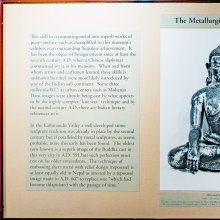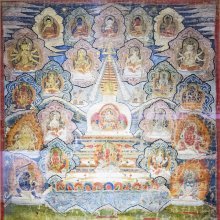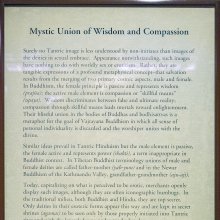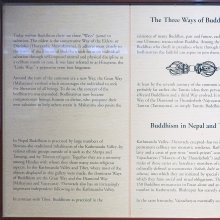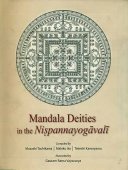Newa, Newar, Newah, Newal: 5 definitions
Introduction:
Newa means something in Buddhism, Pali, the history of ancient India, biology. If you want to know the exact meaning, history, etymology or English translation of this term then check out the descriptions on this page. Add your comment or reference to a book if you want to contribute to this summary article.
Images (photo gallery)
In Buddhism
General definition (in Buddhism)
Source: WikiPedia: BuddhismThe Newa are the indigenous people and the creators of the historical civilization of Nepal's Kathmandu Valley. The valley and surrounding territory have been known from ancient times as Nepal Mandala, its limits ever changing through history.
Newas have lived in the Kathmandu Valley since prehistoric times, and immigrants that arrived at different periods in its history eventually merged with the local population by adopting their language and customs. Newars are a linguistic and cultural community of mostly Tibeto-Burman and some Indo-Aryan ethnicities. They are bound together by a common language and culture. Their common language is Nepal Bhasa ("Newari" according to Statistics Nepal) or the linguistic progenitor of that language. Scholars have also described the Newars as being a nation.
Newa (Nepal Bhasa: नेवाः Newā(h), Classical Nepal Bhasa: नेवार Newār or नेवाल Newāl) (Nepali: नेवार जाति)
India history and geography
Source: OSU Press: Cakrasamvara Samadhi (history)The Newah are the primary inhabitants of the Kathmandu Valley, going back to the Licchavi period, 300-879 CE, which was then known as the "Nepal Valley". The Newah are the descendants of Himalayan peoples, whose language was Tibeto-Burmese, who were assimilated into by Sankrit/Prakrit speaking peoples emigrating from North India,1 some of which were the Śākyas, the family of Śākyamuni, "Sage of the Śākyas", the historical Buddha, Siddhārtha Gautama, born 543 BCE in Lumbini, which is within the southern border of the modern nation-state of Nepal.
Source: Academia: Ritual Period: A Comparative Study of Three Newar Buddhist Menarche ManualsNewar refers to the language spoken and written by the Newars.—Cf. the proposal of two relatively recent monographs on Newar linguistics. See Austin Hale and Kedar P. Shrestha, Newār (Nepal Bhāsā) (München: Lincom Europa, 2006); and Carol Genetti, A Grammar of Dolakha Newar (Berlin/New York: Mouton de Gruyter, 2007). They distance themselves from the indigenous ‘Nepāl Bhāṣā’ and ‘Nevāḥ Bhāy’, the more academic ‘Newari’ (viz. ‘Newārī’) or the Indological ‘Nevārī’.

The history of India traces the identification of countries, villages, towns and other regions of India, as well as mythology, zoology, royal dynasties, rulers, tribes, local festivities and traditions and regional languages. Ancient India enjoyed religious freedom and encourages the path of Dharma, a concept common to Buddhism, Hinduism, and Jainism.
Biology (plants and animals)
Source: Wisdom Library: Local Names of Plants and DrugsNewar in the Marathi language is the name of a plant identified with Barringtonia acutangula (L.) Gaertn. from the Lecythidaceae (Brazilnut) family having the following synonyms: Barringtonia spicata, Eugenia acutangula. For the possible medicinal usage of newar, you can check this page for potential sources and references, although be aware that any some or none of the side-effects may not be mentioned here, wether they be harmful or beneficial to health.
Source: Google Books: CRC World Dictionary (Regional names)Newar in India is the name of a plant defined with Baccaurea courtallensis in various botanical sources. This page contains potential references in Ayurveda, modern medicine, and other folk traditions or local practices It has the synonym Pierardia macrostachya Wight & Arn. (among others).
Example references for further research on medicinal uses or toxicity (see latin names for full list):
· Prodromus Systematis Naturalis Regni Vegetabilis (DC.) (1866)
· Flora of the British India (1887)
· Icon. Pl. Ind. Orient. (1912)
If you are looking for specific details regarding Newar, for example health benefits, chemical composition, diet and recipes, pregnancy safety, side effects, extract dosage, have a look at these references.

This sections includes definitions from the five kingdoms of living things: Animals, Plants, Fungi, Protists and Monera. It will include both the official binomial nomenclature (scientific names usually in Latin) as well as regional spellings and variants.
See also (Relevant definitions)
Starts with: Newaare-paatee, Neware-pati, Newaree, Newari, Newarpati.
Ends with: Apenewa, Ebe onewa, Ginewa, Janewa, Namnewa.
Full-text (+1651): Suryadarshana, Chvaskamini, Purvaseva, Ganeshapuja, Newari, Vivahahoma, Kanyadana, Phalini, Saptapadi, Phalina, Svayamvara, Arohana, Sindura, Padya, Parikrama, Caturthikarman, Shraddha, Agniparikrama, Bhramanayatra, Vistara.
Relevant text
Search found 5 books and stories containing Newa, Newar, Newah, Newal; (plurals include: Newas, Newars, Newahs, Newals). You can also click to the full overview containing English textual excerpts. Below are direct links for the most relevant articles:
Vastu-shastra (5): Temple Architecture (by D. N. Shukla)
Temple architecture in Nepal < [Chapter 12 - History of Hindu Temples (Prāsādas and Vimānas)]
Maha Prajnaparamita Sastra (by Gelongma Karma Migme Chödrön)
Appendix 4 - The story of Hastaka Āṭavika < [Chapter XV - The Arrival of the Bodhisattvas of the Ten Directions]
The Skanda Purana (by G. V. Tagare)
Chapter 39 - The Greatness of Barkareśvara < [Section 2 - Kaumārikā-khaṇḍa]
The gods of northern Buddhism (by Alice Getty)
South Indian Portraits < [January, 1928]
Related products
